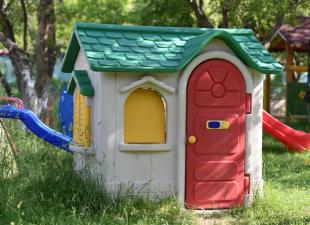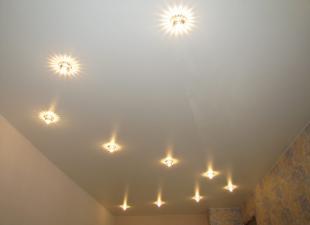Hello everyone! Ceiling LED lamps are in increasing demand - they are durable, economical, easy to install, undemanding in maintenance, allow you to create original lighting of the ceiling and structures, to zone the room with light.
Criterias of choice
LED models have a number of advantages over incandescent, halogen and fluorescent lamps. First of all, these are:

- quick turn-on and no heating;
- lack of flicker (stroboscopic effect, which negatively affects the well-being of people and can cause an attack in patients with epilepsy);
- good focus (the luminous flux is almost not scattered, so its brightness is higher);
- environmental friendliness (the product does not contain mercury and other harmful substances).

To choose the right luminaire model, pay attention to the following parameters:
1. dimensions and type of housing (the luminaire can be fully or partially recessed, or overhead, the gap between the surface of the finish and the ceiling plate should allow free installation of the recessed luminaire and wiring to it);

2. lamp power (for PVC ceilings, there is a limitation on the power of the lamp, otherwise there is a risk of damage to the tension material);
3. the presence of a high-quality radiator (Chinese manufacturers of cheap LED lamps often mask the absence of a normal radiator by installing a matte bulb - such devices quickly fail due to overheating);

4. luminous flux (700 Lm approximately corresponds to the parameters of a conventional 75 W incandescent lamp), it should correspond to your wishes regarding the level of illumination of the room;

5. luminous flux temperature (measured in Kelvin) - you can choose any shade in a wide range from cold blue to warm yellow.
When choosing a luminaire for installation on the ceiling (inset into the ceiling structure), pay attention to the base of the LED light bulb. If you decide to save money and use relatively inexpensive light bulbs from an unknown manufacturer, it is better to choose an option with a common type of base - it will be easier to find a replacement if the lamp fails. Popular sockets for LED lamps are GU10, GU5.3, E27, E14.

When designing LED ceiling lighting, keep in mind that the power of an LED light bulb is approximately 6 times less than that of an incandescent lamp at the same level of illumination. That is, an 8 - 12 W LED luminaire will replace the classic 75 watt lamp.

Pay attention to such property of new models of ceiling LED lamps as dimmability. Conventional energy-saving lamps cannot be used in combination with a dimmer - a device that allows you to smoothly adjust the intensity of the luminous flux to your liking. But today, LED lamps have appeared on the market, designed to work with a dimmer.

Types of LED lamps
Recessed spotlights... They are mounted in a rigid ceiling lining (slatted, plasterboard, suspended), or in a specially prepared box behind a stretch ceiling sheet to avoid sagging of the sheet. Designed for the installation of low-power LEDs (up to 24 W).
The advantages of such lighting fixtures include compactness and durability. Recessed luminaires are not quite suitable for wet rooms - they should be protected with special shades. Typically, they are used to illuminate local areas, as they create a narrow light flux directed downward and to create additional illumination.

Semi-cut and surface mounted spotlights with diffuser... They differ from mortise models with a smaller installation depth, which allows them to be used if there is only enough space between the decorative ceiling and the slab - the base for wiring.
With this choice, you can use higher wattage bulbs to illuminate the room, and diffusers help to ensure that the space is evenly filled with light. Such lamps look advantageous with stretch colored glossy ceilings and help to achieve interesting visual effects.

Soffits... The light source is located in the moving part of the luminaire, the base of which is attached to the decorative ceiling (except for the stretch ceiling). Soffits create narrow light beams, with the help of which they additionally illuminate individual objects or areas. The soffit head rotates in different planes, this helps to illuminate selected parts of the room.

Panels... Recessed, surface-mounted and pendant flat luminaires with a diffusing surface are suitable for uniform general illumination. Due to their small thickness, they do not conceal the height of the ceiling. They differ in shape (it can be strictly geometric or arbitrary) and sizes. Curly and round models are used in living rooms, rectangular ones are suitable for utility rooms and offices.

Conclusion
Each type of LED ceiling light has its own specific use. The choice of model depends on the requirements for the lighting of the room and the general style of the interior. Some types of lamps can be used as complementary ones - for example, create general bathroom lighting using a curly panel, and additionally illuminate the area near the mirror with point devices.
Video on the topic "how to choose LED ceiling lamps for your home":
 parlini.ru Repair of an apartment, a summer residence and a house.
parlini.ru Repair of an apartment, a summer residence and a house.


